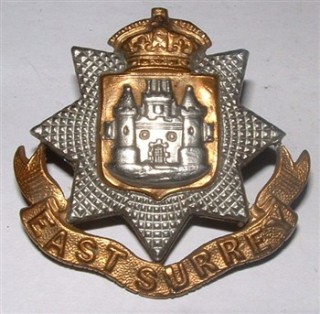Personal Details
Born: 16 January 1895
Family: The second child of Robert and Mary Ann Grace of 42 Watergate Street, Whitchurch, Shropshire. Robert married Cecilia Moth of 41 Broughton Street, Queen’s Road, Battersea on the 25 September 1915 at St Phillip’s Church, Battersea and together they had one son, Frank R.
Education: Robert went to Whitchurch Boys Grammar School.
Civilian Occupation: Followed in his father’s footsteps and became a baker. After the war he returned to Whitchurch and worked in his baker’s shop in Watergate Street, Whitchurch, Shropshire.
Residence: In 1939 the family were living at The Haven, Alkington Road, Whitchurch, Shropshire.
Died: In June 1981 aged 86.
Military Details
Regiment: East Surrey Regiment (previously King’s Royal Rifle Corps)
Rank: Corporal
Service Number: 49975
Date of Enlistment: 21 September 1914
Date of Discharge: 21 February 1919
Reason for Discharge: Demobilisation
Other Information: He enlisted in London on 21 September 1914 and was assigned to the King’s Royal Rifle Corps but was later transferred to the East Surrey Regiment.
Robert was awarded the Campaign Medals (British War Medal, and Victory Medal).

The British War Medal (also known as 'Squeak') was a silver or bronze medal awarded to officers and men of the British and Imperial Forces who either entered a theatre of war or entered service overseas between 5th August 1914 and 11th November 1918 inclusive. This was later extended to services in Russia, Siberia and some other areas in 1919 and 1920. Approximately 6.5 million British War Medals were issued. Approximately 6.4 million of these were the silver versions of this medal. Around 110,000 of a bronze version were issued mainly to Chinese, Maltese and Indian Labour Corps. The front (obv or obverse) of the medal depicts the head of George V. The recipient's service number, rank, name and unit was impressed on the rim.
The Allied Victory Medal (also known as 'Wilfred') was issued by each of the allies. It was decided that each of the allies should each issue their own bronze victory medal with a similar design, similar equivalent wording and identical ribbon. The British medal was designed by W. McMillan. The front depicts a winged classical figure representing victory. Approximately 5.7 million victory medals were issued. Interestingly, eligibility for this medal was more restrictive and not everyone who received the British War Medal ('Squeak') also received the Victory Medal ('Wilfred'). However, in general, all recipients of 'Wilfred' also received 'Squeak' and all recipients of The 1914 Star or The 1914/1915 Star (also known as 'Pip') also received both 'Squeak' and 'Wilfred'. The recipient's service number, rank, name and unit was impressed on the rim.

